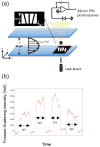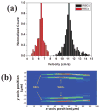Optofluidic device for label-free cell classification from whole blood
- PMID: 22875178
- PMCID: PMC3472004
- DOI: 10.1039/c2lc40560a
Optofluidic device for label-free cell classification from whole blood
Abstract
We demonstrated a unique optofluidic lab-on-a-chip device that can measure optically encoded forward scattering signals. From the design of the spatial pattern, we can measure the position and velocity of each cell in the flow and generate a 2-D cell distribution plot over the cross section of the channel. Moreover, we have demonstrated that the cell distribution is highly sensitive to its size and stiffness. The latter is an important biomarker for cell classification and our method offers a simple and unequivocal method to classify cells by their size and stiffness. We have proved the concept using live and fixed HeLa cells. Due to the stiffness and size difference of neutrophils compared to other types of white blood cells, we have demonstrated detection of neutrophils from other blood cells. Finally, we have performed the test using 5 μL of human blood. In a greatly simplified blood preparation process, skipping the usual steps of anticoagulation, centrifuge, antibody labelling or staining, filtering, etc., we have demonstrated that our device and detection principle can count neutrophils in whole human blood. Our system is compact, inexpensive and simple to fabricate and operate, having a commodity laser diode and a Si PIN photoreceiver as the main pieces of hardware. Although the results are still preliminary, the studies indicate that this optofluidic device holds promise to be a point-of-care and home care device to measure neutrophil concentration, which is the key indicator of the immune functions for cancer patients undergoing chemotherapy.
Figures




Similar articles
-
Optofluidic device for label-free cell classification from whole blood.Methods Mol Biol. 2015;1256:191-200. doi: 10.1007/978-1-4939-2172-0_13. Methods Mol Biol. 2015. PMID: 25626540
-
Integrated optofluidic-microfluidic twin channels: toward diverse application of lab-on-a-chip systems.Sci Rep. 2016 Jan 29;6:19801. doi: 10.1038/srep19801. Sci Rep. 2016. PMID: 26823292 Free PMC article.
-
Highly sensitive optofluidic chips for biochemical liquid assay fabricated by 3D femtosecond laser micromachining followed by polymer coating.Lab Chip. 2012 Oct 7;12(19):3688-93. doi: 10.1039/c2lc40377c. Lab Chip. 2012. PMID: 22814524
-
Emerging optofluidic technologies for point-of-care genetic analysis systems: a review.Anal Bioanal Chem. 2009 Oct;395(3):621-36. doi: 10.1007/s00216-009-2826-5. Epub 2009 May 20. Anal Bioanal Chem. 2009. PMID: 19455313 Review.
-
Frontiers of optofluidics in synthetic biology.Lab Chip. 2012 Oct 7;12(19):3654-65. doi: 10.1039/c2lc40828g. Lab Chip. 2012. PMID: 22895798 Review.
Cited by
-
Computational cell analysis for label-free detection of cell properties in a microfluidic laminar flow.Analyst. 2016 Jun 20;141(13):4142-50. doi: 10.1039/c6an00295a. Analyst. 2016. PMID: 27163941 Free PMC article.
-
Universally applicable three-dimensional hydrodynamic microfluidic flow focusing.Lab Chip. 2013 May 7;13(9):1803-9. doi: 10.1039/c3lc41202d. Lab Chip. 2013. PMID: 23493956 Free PMC article.
-
Miniaturized, multiplexed readout of droplet-based microfluidic assays using time-domain modulation.Lab Chip. 2014 Dec 21;14(24):4638-46. doi: 10.1039/c4lc00819g. Epub 2014 Oct 14. Lab Chip. 2014. PMID: 25311204 Free PMC article.
-
Label-free Optofluidic Cell Classifier Utilizing Support Vector Machines.Sens Actuators B Chem. 2013 Sep;186:327-332. doi: 10.1016/j.snb.2013.06.014. Sens Actuators B Chem. 2013. PMID: 23997428 Free PMC article.
-
Classification of biological micro-objects using optical coherence tomography: in silico study.Biomed Opt Express. 2017 Jul 10;8(8):3606-3626. doi: 10.1364/BOE.8.003606. eCollection 2017 Aug 1. Biomed Opt Express. 2017. PMID: 28856039 Free PMC article.
References
Publication types
MeSH terms
Substances
Grants and funding
LinkOut - more resources
Full Text Sources
Other Literature Sources
Miscellaneous

